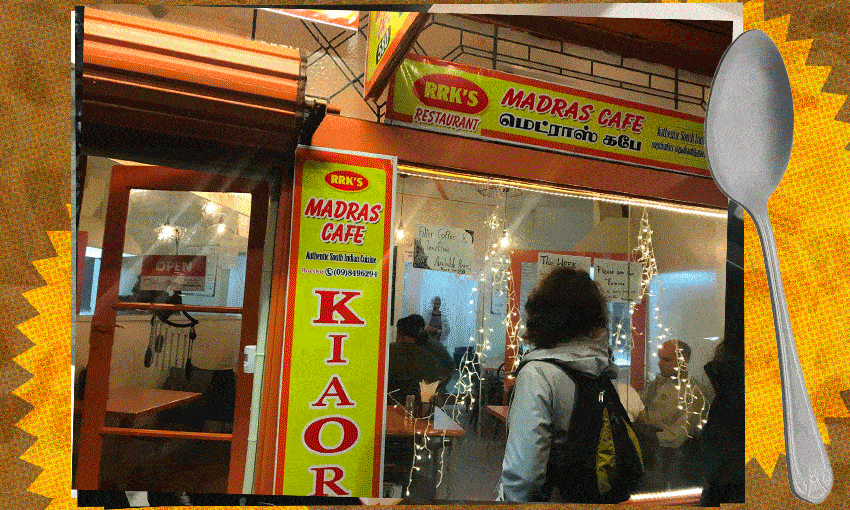There’s a lot to learn, and a lot to eat, on a guided food excursion – especially when you live just five minutes away.
This is an excerpt from our weekly food newsletter, The Boil Up.
Saturday, 5.25pm. It had been one of those weekend days where I’d committed to a few too many social engagements during the day and the thought of heading out at 6pm into the wet weather was frankly an unattractive prospect – especially when home had a heat pump blasting out warm air, a comfy couch and a new episode of Bake Off.
The reason for leaving the house? Food writer Perzen Patel had invited me to join her Sandringham food walk: a three-hour evening food tour in the Auckland suburb, which, for those unacquainted, is a tiny yet bustling corner of central Tāmaki Makaurau brimming with South Asian flavours: halal butchers, spice shops, grocers and a considerable number of restaurants. When people use the phrase “a feast for the senses”, Sandringham should come to mind. All up, a very good reason to leave the house – even if it was freezing.
Despite my sudden bad weather-fuelled trepidation, I reminded myself that I was actually very excited about this and lucky to be invited. I pulled on my rain jacket, packed a few necessities (pen, notebook, phone, wallet, hand sanitiser, and, unfortunately, not an umbrella) in my tiny patent backpack and shuffled out the door into the drizzle. Sandringham is just a couple of kilometres from my house, so I was there in minutes.
We met down a side street, with the seven of us strangers on the tour sharing a packaged snack – tiny crispy masala moon dal – and introducing ourselves to our dining companions for the evening.
Our first stop was Madras Cafe, a newly opened spot which has taken over what was until very recently the Sri Lankan restaurant 7 Siri. As we chowed down on dosa fried in ghee, a fiery chicken kottu, and dipped the airiest idli into ramekins of sambar and housemade coconut chutney, Perzen began sharing stories of the origins of dishes, the techniques behind them and the subtle nuances between various terms and ingredients.
Our next stop was for masala chai and vada pav (spiced potato fritters sandwiched between fluffy dinner rolls) from food trucks situated in a darkened car park tucked behind the main shops. Perzen shared the complicated politics behind vada pav – a seemingly humble street food dish that has become wrapped up with political party loyalty for workers in Mumbai – a story I was especially enchanted by. By this point the rain was so heavy it had made its way inside my raincoat, which is to say, this should have been deeply unpleasant, but it wasn’t. Yes, we were drenched, but the food was delicious, fascinating and had somehow maintained its crunch.
From there we stopped at the fantastically named EggsnMore for chaat (snacks), Chinese-Indian fusion and, of course, an egg dish called gassi, before making a pit stop at Smartdeal Bazaar for chutneys, spiced snacks and the fresh, seasonal mangoes which had recently been delivered to the store. Then we found ourselves at Bawarchi, sharing a massive plastic container of lamb biryani. After that, we were at our last location: Auckland Indian Sweets and Snacks where we huddled around the counter selecting silver-topped sugary kaju katli, cardamon-scented barfi and coils of sticky jaleebi.
I’m aware that it sounds horribly pretentious, but I’ve always avoided anything with the word “tour” in it. As I’ve wandered aimlessly and without direction around overseas cities, I have, on many occasions, silently and unfairly judged those crammed on top of open-air tour buses or the clusters of camera-clad people following a stick-holding guide around ancient ruins. In short, those who feel the need to lean into the “tour” part of the word “tourist”.
But I’ve gained a whole new perspective. Perhaps this tour felt different because it was so small and my tour companions and guide were all especially lovely. What’s more, all of us on the tour lived in Auckland, and some were even regulars to the restaurants and shops in Sandringham. Despite that familiarity, I tried dishes I’d never tasted before and found new layers of meaning to those I had. It turns out having someone else decide where to go next or make the order can be wonderful. We don’t always need to find our own way.



